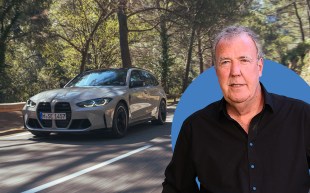The Clarkson review: Porsche 911 Carrera 4S (2013)

The weekly motoring magazine Autocar recently published a truly remarkable road test of Jaguar’s new baby sports car, the F-type. Apparently it has been engineered by a man whose superhuman abilities as a boffin are matched only by his unparalleled excellence behind the wheel. He was described, almost homoerotically, as a blend of Jackie Stewart, Mother Teresa and Wernher von Braun, the German rocket scientist. So not surprisingly his creation is apparently rather special.
We were told that the transmission is silky and beautifully smooth. We learnt that the V8 engine produces a tidal wave of torque and that the V6 “has the soul of a responsive, agile sports car”. The eulogies went on for page after page, and what made this truly astonishing piece of journalism so extraordinary is that the man who wrote it has never actually driven the car.
Search for and buy a Porsche 911 on driving.co.uk
He admits that he determined everything from the passenger seat. And the ability to do this, I must say, is a rare gift. He demonstrated his talents the following week by telling his readers that there are subtle differences between the Subaru BRZ and the Toyota GT86. This is true. There are. Both may be made using exactly the same parts, by exactly the same people, in exactly the same factory, but we are told in the official blurb that each car has slightly different suspension settings.
I’ll be honest with you — I drove both cars back to back on the Top Gear test track and could not tell them apart. It was the same story with the Stig. I told him that they had differently tuned suspensions, but after many laps he came back in to report that they both felt exactly the same.
Not so, it seems. Because according to our friend on Autocar, the Toyota feels slightly softer up front while the Subaru feels a shade more “planted” in faster corners. I felt deeply ashamed not to have spotted this and made a silent vow to redouble my road-testing efforts in the future.
Which brings us on to the new Porsche 911. It’s longer than before and has a wider track. And although 90% of the components are new, it is still very definitely a 911. Except for one thing. It isn’t.
My colleague Richard Hammond is a demented fool, of course, but I’ll give him one thing. He knows the 911 better than anyone and he reckons the new car is a huge step backwards. He tells us that all of the strange little quirks that set this squashed Hitlermobile apart from other cars have been erased in the new model. And that it now feels just like anything else.
He points with special venom at the new electric power steering, saying that this has completely ruined the unique feel. He accepts that electric power steering is necessary for cars to meet new emissions legislation — hydraulic systems take more power from the engine and therefore use more fuel — but he says that as a result of the change, the 911 is George Clooney without the twinkle, Cindy Crawford without the mole.
Naturally the gifted helmsmen on Autocar disagree. They say we should not worry about the new electric power steering setup and tell us that, “information, rich and abundant, comes streaming through” the car’s wheel rim. And that all is well.
Allow me to be the judge in this matter. Ready? Here goes. The steering system in the new Porsche works extremely well. If you turn the wheel anticlockwise, you go left. And if you turn it clockwise, you go right. If you do nothing at all, it goes in a straight line.
There’s more, too. If you push the seat back, you end up further from the windscreen. If you turn the heater up, you will be a bit warmer. And if you turn the radio on, music comes out of the speakers. Unless it’s tuned to Radio 4, in which case you get some Brummies talking about cows.
This is what the 911 has always been about. A taste of the exotic in an-easy-to- use, everything-works package. It’s bloody good value as well. Most interesting cars these days cost upwards of £200,000. They’re so expensive that I was surprised and amazed the other day to find the new Bentley Continental GT Speed is “only” £151,100. But the 394bhp sequential automatic Porsche 911 Carrera 4S I tested last week is a mere £90,346. And this, remember, is a 184mph car. So that’s proper performance with a Poundland price tag.
There are some lovely details. It has a satellite navigation system that has been loaded with a current map of Britain. Unlike, say, the Audi R8, which has been given a map not used since your farmer had oxen and all it said over Somerset was: “There be witches.” In one journey in the Audi it simply drove me into a field and gave up. The exact same journey in the Porsche was a breeze.
I also like the way that, in the Porsche, you can choose which sporty element you’d like at any given moment. In most cars, you push the Sport button and it alters everything; the gearbox, the exhaust noise, the steering and the engine response. In the 911 each one of these can be adjusted individually.
I should explain at this point that I am not a 911 enthusiast. But in the same way that a Chelsea fan will admit that behind the gum and the bad temper, Sir Ferguson is a bloody good manager, I can see this is a bloody good car.
There are some niggles, though. When the differentials are cold and you are manoeuvring in a tight space, the front wheels just plough straight on. In this respect, it’s a bit like my P45 micro-car. And on the move, the accelerator pedal feels mushy. There is no instant response from the engine, partly because it’s fed in an old-fashioned way and partly because the new seven-speed gearbox is a bit dimwitted.
There’s something else too. The four-wheel-drive system is a complete waste of time, unless you live in Val d’Isère. Which you don’t. Or are a road tester on Autocar. They say the all-wheel-drive grip makes the car slightly more sure-footed than a two-wheel-drive version. But I’m not sure. I think that on a normal road, it just adds weight, chews fuel and offers absolutely no benefit.
I have more advice on the 911 range. As well as a new cabriolet, in the fullness of time there will be a Turbo and all sorts of hunkered-down, uncomfortable track-day monsters. Forget all of them. A 911 is a sports car, pure and simple. If you add a turbo, it becomes a supercar, something it is not. If you take off the roof, or fit a roll cage or do anything at all, you are adding or subtracting ingredients to a recipe that was fine in the first place.
You buy a 911 like you buy wine in a restaurant. You go for the second cheapest. And that’s the two-wheel-drive Carrera S. Autocar agrees with me on this. It says the two-wheel-drive versions are purer and more involving. Doubtless this is so. But more importantly, some of them are more than £17,000 cheaper and make you look less of a plonker.
Verdict ★★★☆☆
Don’t be a plonker — go for the plonk instead
Factfile
Porsche 911 Carrera 4S
- Price:
- £90,346
- Engine:
- 3800cc, 6 cylinders
- Power:
- 394bhp @ 7400rpm
- Torque:
- 324 lb ft @ 5600rpm
- Transmission:
- 7-speed sequential automatic
- Acceleration:
- 0-62mph: 4.3sec
- Top Speed:
- 184mph
- Fuel:
- 31mpg (combined)
- CO2:
- 215g/km
- Road Tax Band:
- K (£600 for first year)
- Dimensions:
- L 4491mm W 1852mm H 1296mm
Search for and buy a Porsche 911 on driving.co.uk





